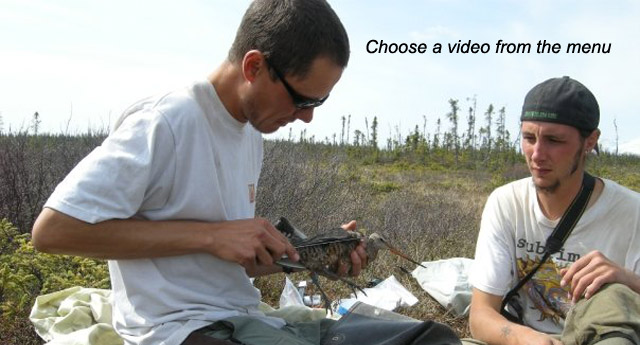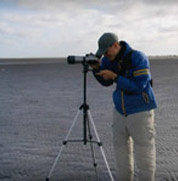Nate Senner
How do you conserve what you can't follow? Tracking Hudsonian Godwit migration across the globe.

Other Resources
Nate's Profile

1. What is the focus of your research?
Hudsonian Godwits and other migratory birds must be able to time their migrations so that they can make use of abundant food resources at locations spread across much of the globe. Without the benefit of these resources—like insects in the Arctic or mussels and worms on Chiloe Island in Chile—godwits would be unable to successfully complete their migrations or raise young each summer. Because global climate change is warming some parts of the globe faster than others, the ability of godwits and other migratory birds to time their migrations to make use of these resources has been effected. I am trying to understand how godwits may be able to alter their migration to accommodate these changes. We are doing this by following individual godwits across the globe over the course of a number of years so that we can identify how they may make changes in between years and how the different populations may be adapting differently to climate change.
2. What got you interested in this line of research?
My father was a biologist and so as a little kid, pretty much every family vacation was somehow oriented toward birds and biology—whether it was a trip to the local wildlife refuge on the way to the beach or a stop at some natural history museum along the way to my grandparents’ house. But it wasn’t until I was a bit older and I took a trip to the Copper River Delta in southcentral Alaska that birds really took hold of my imagination. On that trip, we walked onto the flats of a nearby bay and were surrounded by hundreds of thousands of small shorebirds that all seemed entirely oblivious to our presence. Something about that close proximity, yet complete isolation really engaged me and from that point on I was completely hooked on birds. My progression toward becoming a scientist really grew out of that initial interest in birds; first I was a bird watcher and then a birder and finally a biologist.
3. Where did you grow up, and how does this relate to what you are doing now?
I’ve lived in a number of states across the country, but Alaska remains the place that I call home. Living in Alaska and having an interest in biology really fed into each other. Starting at the age of 15, I was able to travel to a different remote part of the state each summer to work for various local biologists at their study sites. Seeing all of those truly remote and wild places really influenced the kind of biological questions that I was interested in and has largely dictated the type of studies that I am involved in now; I don’t think that I would have the confidence to work in the remote Arctic now if not for those experiences when I was a teenager.
4. What do you like to do in your spare time?
My wife always laughs at me, because a lot of what I do in my spare time is watch birds. Despite the fact that I study birds for my job, it never quite feels like bird watching while I am out actually collecting data. So much of my free time is taken up by going to cool places to watch birds (We recently took a trip to the canyon lands of Arizona for just that purpose). Aside from that, though, I am an avid long-distance runner and I compete in races all around the northeast and I like to hike and camp with my wife.
5. Why is it important for us to conserve biodiversity, and how does this relate to your career path?
There are two very persuasive arguments, in my mind, as to why we should protect the earth’s biodiversity. The first has to do with economics and our physical well-being—healthy ecosystems provide us with services that are central to our way of life. The other has to do with our psychological well-being—healthy ecosystems provide us with an escape from the lives that we have created for ourselves elsewhere. I think that these arguments are equally compelling and inspire me to think about my work from different points of view. First, how must we design our societies such that they maintain healthy and whole ecosystems that can continue to sustain our way of life. And, second, what must we do to protect our environment such that we can always know that there are wild places surrounding us where everything from beetles to bears are still thriving. My current work aims, at some level, to address both of these concerns and to understand how we can make decisions that will allow birds to continue their migrations into the future.








